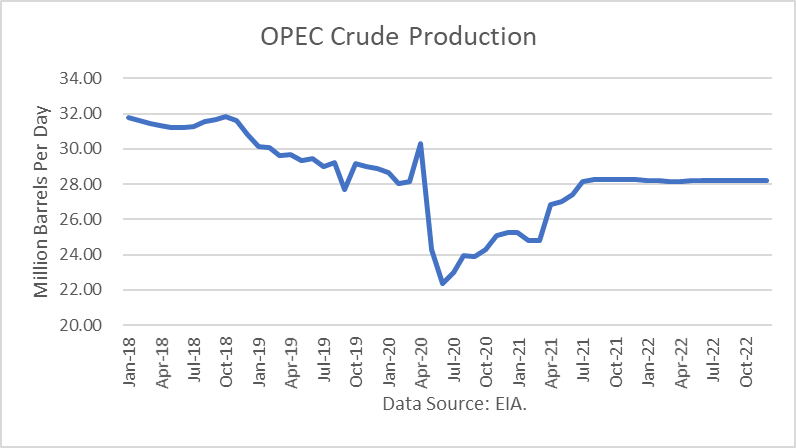The Energy Information Administration released its Short-Term Energy Outlook for February, and it shows that OECD oil inventories likely peaked at 3.210 billion in July 2020. In January 2021, it estimated stocks dropped by 15 million barrels to end at 3.030 billion, 127 million barrels higher than a year ago.
The EIA estimated global oil production at 93.95 million barrels per day (mmbd) for January, compared to global oil consumption of 93.89 mmbd. That implies an oversupply of 60,000 b/d, or 1.9 million barrels for the month. That implies non-OECD stocks dropped by 17 million barrels.
For 2021, OECD inventories are now projected to draw by net 86 million barrels to 2.959 billion. For 2022 it forecasts that stocks will draw by 24 million barrels to end the year at 2.935 billion.

The EIA forecast was made incorporates the OPEC+ decision to cut production and exports. According to OPEC’s press release January 5, 2021:
“The Meeting acknowledged the need to gradually return 2 mb/d to the market, with the pace being determined according to market conditions. It reconfirmed the decision made at the 12th ONOMM to increase production by 0.5 mb/d starting in January 2021, and adjusting the production reduction from 7.7 mb/d to 7.2 mb/d.”
The adjustments to the production level for February and March 2021 will be implemented as per the distribution detailed in the table below.

The EIA has assumed the following OPEC production levels for its STEO:

Oil Price Implications
I updated my linear regression between OECD oil inventories and WTI crude oil prices for the period 2010 through 2020. As expected, there are periods where the price deviates greatly from the regression model. But overall, the model provides a reasonably high r-square result of 82 percent.

I used the model to assess WTI oil prices for the EIA forecast period through 2021 and 2022 and compared the regression equation forecast to actual NYMEX futures prices as of February 9th. The result is that oil futures prices are presently overpriced through the forecast horizon until December 2022.

Uncertainties
April 2020 proved that oil prices can move dramatically based on market expectations and that they can drop far below the model’s valuations, whereas prices in May through December proved that the market factors-in future expectations beyond current inventory levels.
In addition to uncertainty of how deeply and how long the coronavirus will disrupt the U.S. and world oil consumption, another issue is how long OPEC+ will constrain production, knowing that high prices provide incentive to other producers, such as shale, to restore their production.
Another uncertainty is whether the U.S. will lift sanctions on Iran while rejoining the Iran nuclear deal. Biden has clearly stated that he wants the U.S. back in the deal. That could put around 2 million barrels a day back into the world market.
Conclusions
Given the recovery in oil prices, some are extrapolating further rises to $100 per barrel. The inventory forecast above clearly does not support such a rise.
A projection of $100 also does not consider supply-side responses. It also ignores the now-likely lifting of Iranian sanctions.
Check back to see my next post!
Best,
Robert Boslego
INO.com Contributor - Energies
Disclosure: This contributor does not own any stocks mentioned in this article. This article is the opinion of the contributor themselves. The above is a matter of opinion provided for general information purposes only and is not intended as investment advice. This contributor is not receiving compensation (other than from INO.com) for their opinion.
